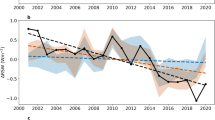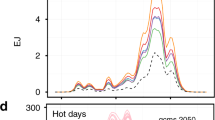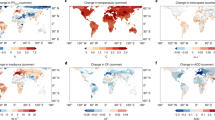Abstract
The worldwide energy consumption in 2006 was close to 498 exajoules. This is equivalent to an energy convergence of 15.8 TW into the populated regions, where energy is consumed and dissipated into the atmosphere as heat. Although energy consumption is sparsely distributed over the vast Earth surface and is only about 0.3% of the total energy transport to the extratropics by atmospheric and oceanic circulations, this anthropogenic heating could disrupt the normal atmospheric circulation pattern and produce a far-reaching effect on surface air temperature. We identify the plausible climate impacts of energy consumption using a global climate model. The results show that the inclusion of energy use at 86 model grid points where it exceeds 0.4 W m−2 can lead to remote surface temperature changes by as much as 1 K in mid- and high latitudes in winter and autumn over North America and Eurasia. These regions correspond well to areas with large differences in surface temperature trends between observations and global warming simulations forced by all natural and anthropogenic forcings1. We conclude that energy consumption is probably a missing forcing for the additional winter warming trends in observations.
This is a preview of subscription content, access via your institution
Access options
Subscribe to this journal
Receive 12 print issues and online access
$209.00 per year
only $17.42 per issue
Buy this article
- Purchase on Springer Link
- Instant access to full article PDF
Prices may be subject to local taxes which are calculated during checkout




Similar content being viewed by others
References
Knutson, T. R. et al. Assessment of twentieth-century regional surface temperature trends using the GFDL CM2 coupled models. J. Clim. 19, 1624–1651 (2006).
Trenberth, K. E. et al. in IPCC Climate Change: The Physical Science Basis (eds Solomon, S. et al.) 235–336 (Cambridge Univ. Press, 2007).
Ramanathan, V., Crutzen, P. J., Kiehl, J. T. & Rosenfeld, D. Aerosols, climate, and the hydrological cycle. Science 294, 2119–2124 (2001).
Feddema, J. J. et al. The importance of land-cover change in simulating future climates. Science 310, 1674–1678 (2005).
Rosenfeld, D. et al. Flood or drought: How do aerosols affect precipitation? Science 321, 1309–1313 (2008).
Ramanathan, V. et al. Warming trends in Asia amplified by brown cloud solar absorption. Nature 448, 575–578 (2007).
Ramanathan, V. & Carmichael, G. Global and regional climate changes due to black carbon. Nature Geosci. 1, 221–227 (2008).
Landsberg, H. E. The Urban Climate (Academic, 1981).
Oke, T. R. The energetic basis of the urban heat island. Q. J. R. Meteorol. Soc. 108, 1–24 (1982).
Bornstein, R. & Lin, Q. Urban heat islands and summertime convective thunderstorms in Atlanta: Three case studies. Atmos. Environ. 34, 507–516 (2000).
Shepherd, J. M., Pierce, H. & Negri, A. J. Rainfall modification by major urban areas: Observations from spaceborne rain radar on the TRMM satellite. J. Appl. Meteorol. 41, 689–701 (2002).
Washington, W. M. Numerical climate-change experiments: The effect of man’s production of thermal energy. J. Appl. Meteorol. 11, 769–772 (1972).
Washington, W. M. & Chervin, R. M. Regional climatic effects of large-scale thermal pollution simulation studies with the NCAR general circulation model. J. Appl. Meteorol. 18, 1501–1511 (1979).
Ichinose, T., Shimodozono, K. & Hanaki, K. Impact of anthropogenic heat on urban climate in Tokyo. Atmos. Environ. 33, 3897–3909 (1999).
Kusaka, H. & Kimura, F. Thermal effects of urban canyon structure on the nocturnal heat island: Numerical experiment using a mesoscale model coupled with an urban canopy model. J. Appl. Meteorol. 43, 1899–1910 (2004).
Oleson, K. W., Bonan, G. B., Feddema, J. & Jackson, T. An examination of urban heat island characteristics in a global climate model. Int. J. Climatol. 31, 1845–1865 (2011).
Trenberth, K. E. & Caron, J. M. Estimates of meridional atmosphere and ocean heat transports. J. Clim. 14, 3433–3443 (2001).
Budyko, M., Drosdov, I. O. A. & Yudin, M. I. Influence of economic activity on climate. Modern Problems of Climatology (Collection of Articles), FTD-HT-23-1338-67 (USAF, 1966).
Sellers, W. D. Global climatic model based on the energy balance of the Earth-atmosphere system. J. Appl. Meteorol. 8, 392–400 (1969).
Block, A., Keuler, K. & Schaller, E. Impacts of anthropogenic heat on regional climate patterns. Geophys. Res. Lett. 31, L12211 (2004).
Collins, W. D. et al. The formulation and atmospheric simulation of the Community Atmosphere Model version 3 (CAM3). J. Clim. 19, 2144–2161 (2006).
IPCC Climate Change 2007: The Scientific Basis (eds S. Solomon et al.) (Cambridge Univ. Press (2007).
Hansen, J., Sato, M. & Ruedy, R. Radiative forcing and climate response. J. Geophys. Res. 102, 6831–6864 (1997).
Ring, M. J. & Plumb, R. A. The response of a simplified GCM to axisymmetric forcings: Applicability of the fluctuation-dissipation theorem. J. Atmos. Sci. 65, 3880–3898 (2008).
International Energy Agency, World Energy Demand and Economic Outlook. International Energy Outlook 2009, 7–20 (2009).
Gurney, K. et al. High resolution fossil fuel combustion CO2 emission fluxes for the United States. Environ. Sci. Technol. 43, 5535–5541 (2009).
Rayner, P. J., Raupach, M. R., Paget, M., Peylin, P. & Koffi, E. A new global gridded data set of CO2 emissions from fossil fuel combustion: Methodology and evaluation. J. Geophys. Res. 115, D19306 (2010).
Acknowledgements
This research was in part supported by the National Science Foundation (ATM-0833001 and ATM-0832915), the Office of Science (BER), the US Department of Energy Regional and Global Climate Modelling programme (DE-SC0004974) and Atmospheric System Research programme (DE-SC0000805), and the NOAA CPO/CPPA programme (NA10OAR4310168). Portions of this study were also supported by the DOE Cooperative Agreement No. DE-FC02-97ER62402, and the National Science Foundation. The NCAR is sponsored by the National Science Foundation.
Author information
Authors and Affiliations
Contributions
M.C. conceived the study with G.J.Z. M.C. compiled the global energy consumption data. G.J.Z. performed the numerical simulations and analysed model output. Both G.J.Z. and M.C. interpreted the results and wrote the paper. A.H. analysed the surface temperature trend differences between observations and CCSM4 global warming simulations, and contributed to revising the paper.
Corresponding author
Ethics declarations
Competing interests
The authors declare no competing financial interests.
Supplementary information
Supplementary Information
Supplementary Information (PDF 2522 kb)
Rights and permissions
About this article
Cite this article
Zhang, G., Cai, M. & Hu, A. Energy consumption and the unexplained winter warming over northern Asia and North America. Nature Clim Change 3, 466–470 (2013). https://doi.org/10.1038/nclimate1803
Received:
Accepted:
Published:
Issue Date:
DOI: https://doi.org/10.1038/nclimate1803
This article is cited by
-
Anthropogenic heat release due to energy consumption exacerbates European summer extreme high temperature
Climate Dynamics (2023)
-
Urbanization Impact on Regional Climate and Extreme Weather: Current Understanding, Uncertainties, and Future Research Directions
Advances in Atmospheric Sciences (2022)
-
Assessing the environmental impact of China’s tourism activities: a tourism heat footprint method
Environmental Science and Pollution Research (2021)
-
Climate response to introduction of the ESA CCI land cover data to the NCAR CESM
Climate Dynamics (2021)
-
High-spatiotemporal-resolution mapping of global urban change from 1985 to 2015
Nature Sustainability (2020)



